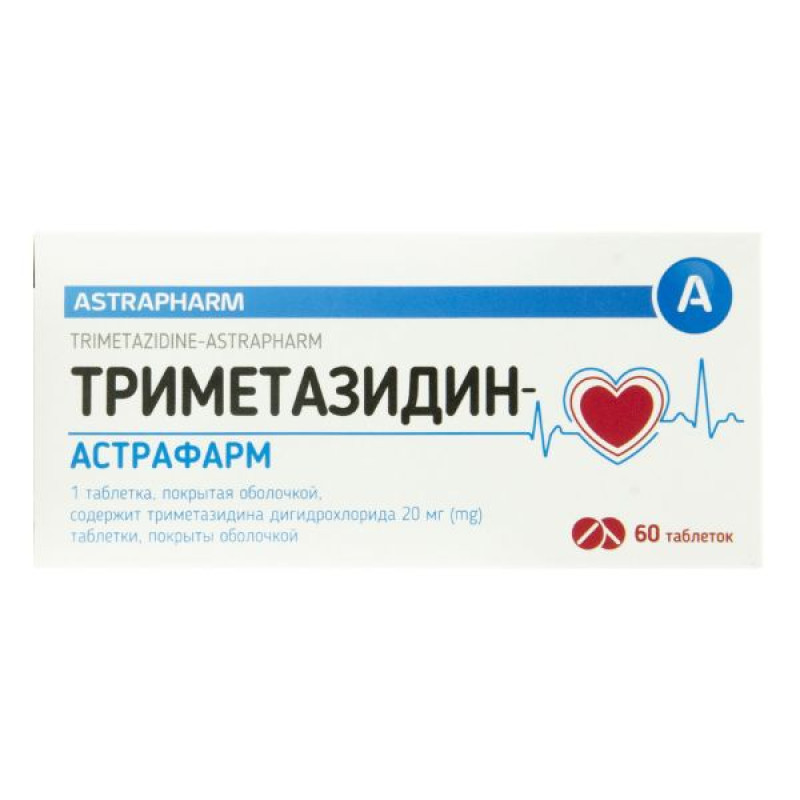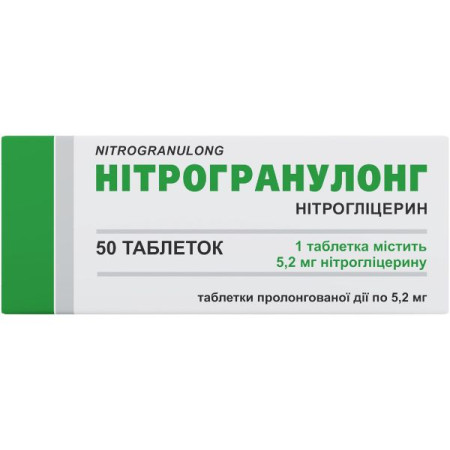Trimetazidine-Astrapharm film-coated tablets 20 mg blister No. 60

Instructions Trimetazidine-Astrapharm film-coated tablets 20 mg blister No. 60
Composition
active ingredient: trimetazidine;
1 tablet contains trimetazidine dihydrochloride 20 mg;
excipients: corn starch, mannitol E 421, povidone, talc, magnesium stearate, “SeleCoat™” coating (hypromellose, polyethylene glycol (macrogol) 6000, titanium dioxide E 171), dye “Azorubine” (carmoisine) E 122, dye “Yellow sunset FCF” E 110.
Dosage form
Film-coated tablets.
Main physicochemical properties: round tablets with a biconvex surface, covered with a red shell. Two layers are visible on the break.
Pharmacotherapeutic group
Cardiological drugs. Trimetazidine. ATC code C01E B15.
Pharmacological properties
Pharmacodynamics
Mechanism of action.
By preserving energy metabolism in cells suffering from hypoxia or ischemia, trimetazidine prevents a decrease in intracellular ATP levels, thereby ensuring the proper functioning of ion pumps and transmembrane sodium-potassium flux while maintaining cellular homeostasis.
Trimetazidine inhibits β-oxidation of fatty acids by blocking long-chain 3-ketoacyl-CoA thiolase (3-CAT), which increases glucose oxidation. In cells under ischemic conditions, the process of obtaining energy through glucose oxidation requires less oxygen compared to the process of obtaining energy through β-oxidation of fatty acids. Strengthening the process of glucose oxidation optimizes energy processes in cells and, accordingly, maintains sufficient energy metabolism under ischemic conditions.
Pharmacodynamic effects.
In patients with coronary heart disease, trimetazidine acts as a metabolic agent, preserving intracellular levels of high-energy phosphates in the myocardium. The effects are achieved without concomitant hemodynamic effects.
Pharmacokinetics
The maximum concentration of trimetazidine in the blood is observed on average 5 hours after taking the drug. During the day, the concentration of trimetazidine in the blood plasma is stable: within 11 hours after taking the drug - not less than 75% of the maximum concentration. The steady-state concentration is established no later than 60 hours. Food intake does not affect the pharmacokinetic characteristics of trimetazidine. The volume of distribution is 4.8 l/kg. Protein binding is low: according to in vitro measurements - 16%.
Trimetazidine is excreted mainly in the urine, mainly unchanged. The half-life is on average 7 hours in healthy young volunteers and 12 hours in people over 65 years of age. The complete elimination of trimetazidine is the result of renal clearance, which is directly correlated with creatinine clearance, and to a lesser extent, is the result of hepatic clearance, which decreases with age.
Special patient groups.
Elderly patients: In elderly patients, increased trimetazidine concentrations may occur due to age-related decline in renal function.
Renal impairment: The concentration of trimetazidine in the blood increases in patients with moderate renal insufficiency (creatinine clearance - 30-60 ml/min) and in patients with severe renal insufficiency (creatinine clearance < 30 ml/min).
Indication
In adults, trimetazidine is indicated for the symptomatic treatment of stable angina pectoris when first-line antianginal drugs are ineffective or intolerant.
Contraindication
Hypersensitivity to the active substance or to any component of the drug, Parkinson's disease, parkinsonian symptoms, tremor, restless legs syndrome and other movement disorders related to the above; severe renal failure (creatinine clearance < 30 ml/min).
Interaction with other medicinal products and other types of interactions
No interactions of Trimetazidine-Astrapharm with other drugs have been identified, in particular: with β-adrenergic blockers, calcium antagonists, nitrates, heparin, hypolipidemic agents, digitalis preparations. Trimetazidine can be used in combination with calciparin, vitamin K antagonists, acetylsalicylic acid (aspirin).
Application features
Trimetazidine may cause or worsen parkinsonism symptoms (tremor, akinesia, muscle hypertonia), which should be regularly monitored, especially in elderly patients. In doubtful cases, patients should be referred to a neurologist for appropriate examinations.
Trimetazide-Astrapharm should not be used to relieve angina attacks. It should not be prescribed for unstable angina or myocardial infarction as primary therapy in the prehospital stage or in the first days of hospitalization.
In the event of an attack of unstable angina during current therapy, it is necessary to review the patient's disease status and adjust the treatment (drug therapy and the possibility of revascularization).
These events are rare and usually resolve in most patients within 4 months of discontinuation of the drug. If parkinsonism symptoms persist for more than 4 months after discontinuation of the drug, a neurologist should be consulted.
Cases of falls associated with gait instability or hypotension have been reported, particularly in patients receiving antihypertensive medications (see section 4.8).
Trimetazidine should be prescribed with caution to patients at risk of increased concentrations:
patients with moderate renal insufficiency (see sections "Pharmacokinetics" and "Method of administration and dosage");
elderly patients (see section "Method of administration and dosage").
It is recommended that such patients monitor functional parameters and reduce the dose if necessary.
There is no information on the use of the drug in hepatic insufficiency.
Patients with diabetes do not need to adjust the dosage of the drug.
The use of the drug does not affect preparation for anesthesia.
The presence of a dye in the composition of the drug may cause allergic-type reactions, including bronchial asthma, especially in patients who are allergic to acetylsalicylic acid.
The presence of dyes in the composition of the drug ["Azorubine" (carmaizine) (E 122), "Yellow sunset FCF" dye (E 110)] may cause allergic-type reactions, including bronchial asthma, especially in patients who are allergic to acetylsalicylic acid.
Ability to influence reaction speed when driving vehicles or other mechanisms
Trimetazidine does not affect hemodynamics, however, cases of dizziness and drowsiness have been reported (see section "Adverse reactions"), which may affect the ability to drive and use machines.
Use during pregnancy or breastfeeding
It is not recommended to take the drug during pregnancy or breastfeeding.
If its use is necessary, breastfeeding should be discontinued, as it is not known whether the drug passes into breast milk.
Method of administration and doses
Trimetazidine-Astrapharm is taken orally, 1 tablet (20 mg) 3 times a day during meals, washed down with 1 glass of water. The duration of treatment is determined by the doctor depending on the severity and course of the disease.
Patients with renal failure
In patients with moderate renal impairment (creatinine clearance 30-60 ml/min), the recommended dose of trimetazidine is 1 tablet (20 mg) 2 times a day, morning and evening with meals.
Elderly patients
Elderly patients are more sensitive to the effects of trimetazidine due to age-related decline in renal function. For patients with moderate renal impairment (creatinine clearance 30-60 ml/min), the recommended dose of trimetazidine is 1 tablet (20 mg) 2 times a day, morning and evening with meals.
For elderly patients, the dose should be carefully titrated.
Children
The safety and efficacy of trimetazidine in children (under 18 years of age) have not been studied. Data are not available.
Overdose
No cases of drug overdose have been reported.
In case of overdose, symptomatic therapy is indicated.
Adverse reactions
Nervous system: headache, dizziness, parkinsonism symptoms (tremor, akinesia, muscle hypertonia, gait instability, restless legs syndrome and other movement disorders related to the above, which usually disappear after discontinuation of treatment; sleep disorders (insomnia, drowsiness).
Cardiovascular system: palpitations, extrasystole, tachycardia, arterial hypotension; orthostatic hypotension, which may be associated with malaise, dizziness or falls, particularly in patients taking antihypertensive drugs; facial flushing.
On the part of the digestive tract: pain in the epigastric region of the abdomen, diarrhea, dyspepsia, nausea and vomiting, constipation.
Skin and subcutaneous tissue disorders: rash, itching, urticaria, acute generalized exanthematous pustular eruptions, angioedema.
General disorders: asthenia.
From the blood system: agranulocytosis, thrombocytopenia, thrombocytopenic purpura.
From the hepatobiliary system: hepatitis.
Expiration date
3 years.
Storage conditions
Store in the original packaging at a temperature not exceeding 25 °C.
Keep out of reach of children.
Packaging
30 tablets in a blister, 2 blisters in a box.
Vacation category
According to the recipe.
Producer
"ASTRAPHARM" LLC.
Location of the manufacturer and its business address
Ukraine, 08132, Kyiv-Svyatoshynskyi district, Vyshneve, Kyivska st., 6.
There are no reviews for this product.
There are no reviews for this product, be the first to leave your review.
No questions about this product, be the first and ask your question.





